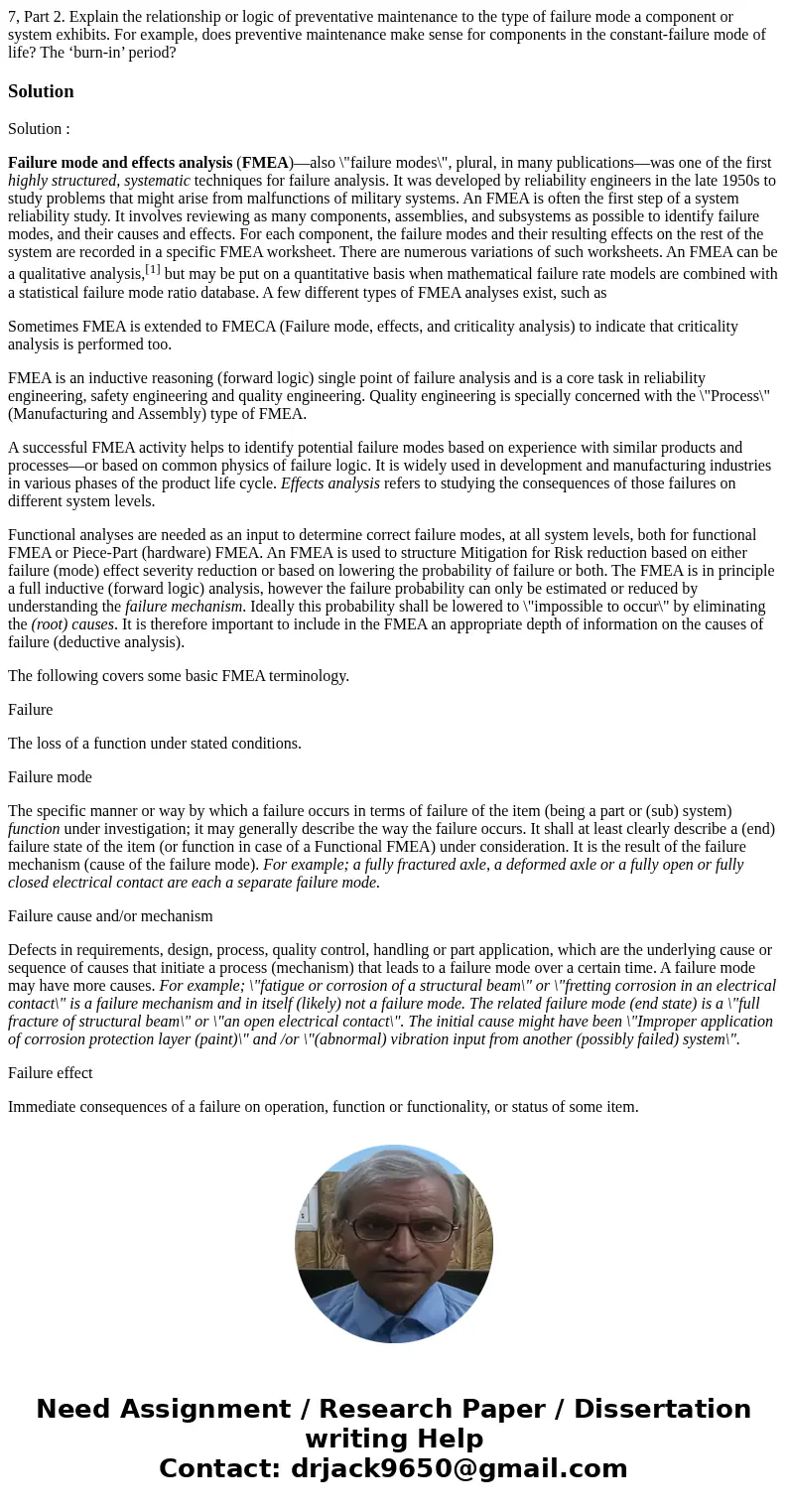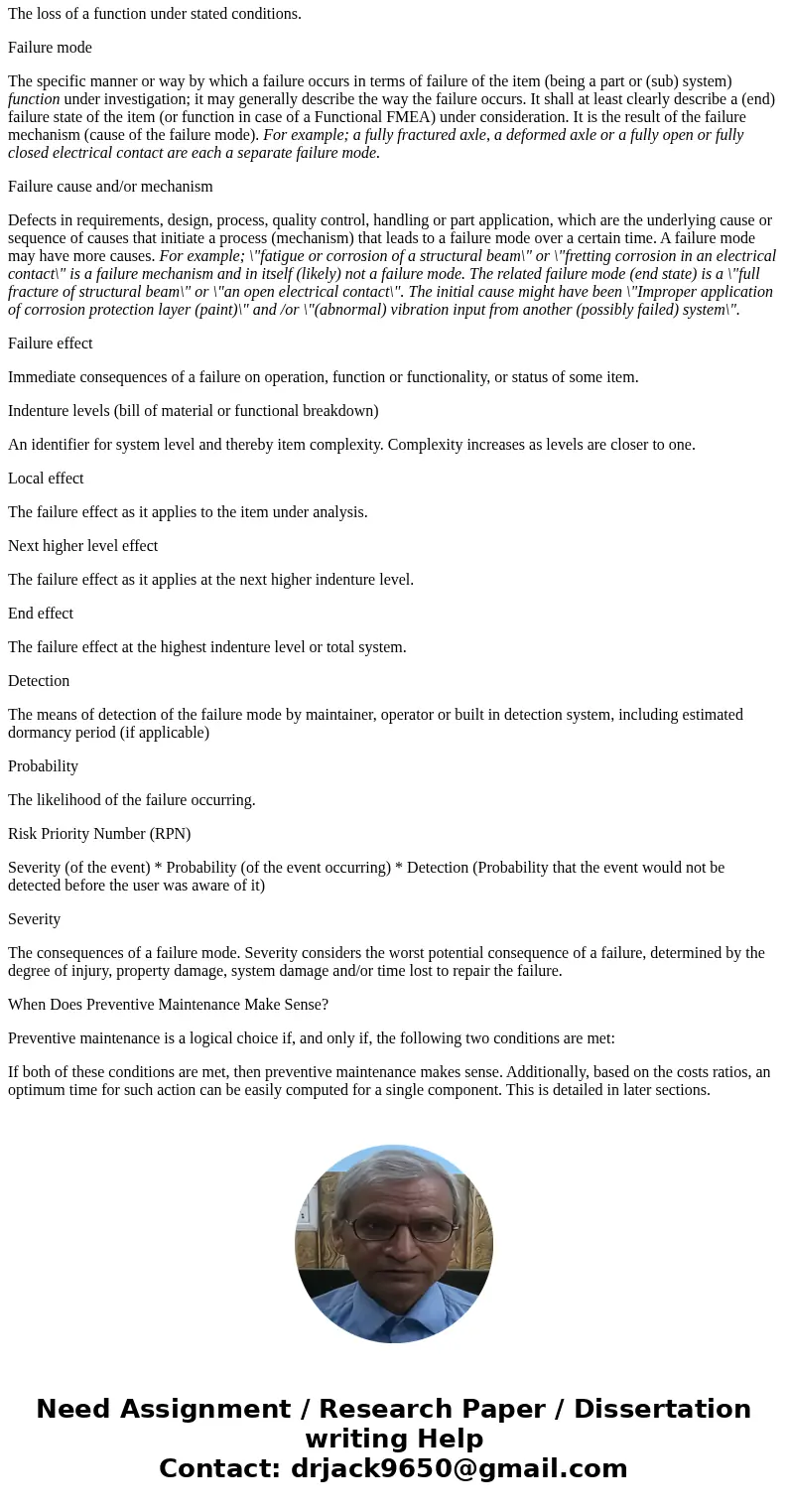7 Part 2 Explain the relationship or logic of preventative m
7, Part 2. Explain the relationship or logic of preventative maintenance to the type of failure mode a component or system exhibits. For example, does preventive maintenance make sense for components in the constant-failure mode of life? The ‘burn-in’ period?
Solution
Solution :
Failure mode and effects analysis (FMEA)—also \"failure modes\", plural, in many publications—was one of the first highly structured, systematic techniques for failure analysis. It was developed by reliability engineers in the late 1950s to study problems that might arise from malfunctions of military systems. An FMEA is often the first step of a system reliability study. It involves reviewing as many components, assemblies, and subsystems as possible to identify failure modes, and their causes and effects. For each component, the failure modes and their resulting effects on the rest of the system are recorded in a specific FMEA worksheet. There are numerous variations of such worksheets. An FMEA can be a qualitative analysis,[1] but may be put on a quantitative basis when mathematical failure rate models are combined with a statistical failure mode ratio database. A few different types of FMEA analyses exist, such as
Sometimes FMEA is extended to FMECA (Failure mode, effects, and criticality analysis) to indicate that criticality analysis is performed too.
FMEA is an inductive reasoning (forward logic) single point of failure analysis and is a core task in reliability engineering, safety engineering and quality engineering. Quality engineering is specially concerned with the \"Process\" (Manufacturing and Assembly) type of FMEA.
A successful FMEA activity helps to identify potential failure modes based on experience with similar products and processes—or based on common physics of failure logic. It is widely used in development and manufacturing industries in various phases of the product life cycle. Effects analysis refers to studying the consequences of those failures on different system levels.
Functional analyses are needed as an input to determine correct failure modes, at all system levels, both for functional FMEA or Piece-Part (hardware) FMEA. An FMEA is used to structure Mitigation for Risk reduction based on either failure (mode) effect severity reduction or based on lowering the probability of failure or both. The FMEA is in principle a full inductive (forward logic) analysis, however the failure probability can only be estimated or reduced by understanding the failure mechanism. Ideally this probability shall be lowered to \"impossible to occur\" by eliminating the (root) causes. It is therefore important to include in the FMEA an appropriate depth of information on the causes of failure (deductive analysis).
The following covers some basic FMEA terminology.
Failure
The loss of a function under stated conditions.
Failure mode
The specific manner or way by which a failure occurs in terms of failure of the item (being a part or (sub) system) function under investigation; it may generally describe the way the failure occurs. It shall at least clearly describe a (end) failure state of the item (or function in case of a Functional FMEA) under consideration. It is the result of the failure mechanism (cause of the failure mode). For example; a fully fractured axle, a deformed axle or a fully open or fully closed electrical contact are each a separate failure mode.
Failure cause and/or mechanism
Defects in requirements, design, process, quality control, handling or part application, which are the underlying cause or sequence of causes that initiate a process (mechanism) that leads to a failure mode over a certain time. A failure mode may have more causes. For example; \"fatigue or corrosion of a structural beam\" or \"fretting corrosion in an electrical contact\" is a failure mechanism and in itself (likely) not a failure mode. The related failure mode (end state) is a \"full fracture of structural beam\" or \"an open electrical contact\". The initial cause might have been \"Improper application of corrosion protection layer (paint)\" and /or \"(abnormal) vibration input from another (possibly failed) system\".
Failure effect
Immediate consequences of a failure on operation, function or functionality, or status of some item.
Indenture levels (bill of material or functional breakdown)
An identifier for system level and thereby item complexity. Complexity increases as levels are closer to one.
Local effect
The failure effect as it applies to the item under analysis.
Next higher level effect
The failure effect as it applies at the next higher indenture level.
End effect
The failure effect at the highest indenture level or total system.
Detection
The means of detection of the failure mode by maintainer, operator or built in detection system, including estimated dormancy period (if applicable)
Probability
The likelihood of the failure occurring.
Risk Priority Number (RPN)
Severity (of the event) * Probability (of the event occurring) * Detection (Probability that the event would not be detected before the user was aware of it)
Severity
The consequences of a failure mode. Severity considers the worst potential consequence of a failure, determined by the degree of injury, property damage, system damage and/or time lost to repair the failure.
When Does Preventive Maintenance Make Sense?
Preventive maintenance is a logical choice if, and only if, the following two conditions are met:
If both of these conditions are met, then preventive maintenance makes sense. Additionally, based on the costs ratios, an optimum time for such action can be easily computed for a single component. This is detailed in later sections.


 Homework Sourse
Homework Sourse